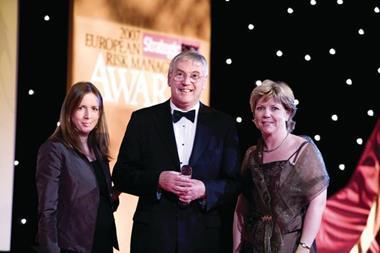One of the biggest challenges facing large multi-nationals today is ensuring that there is a common approach to risk throughout all their operations worldwide.
Clearly compliance with both internal and external requirements is essential, but a successful enterprise risk management (ERM) programme will go further than this, optimising the synergies that arise from a common single approach and common ways of working, and allowing different operations to share best practice. This is the challenge that Diageo, the world's leading premium drinks business, has set out to meet with its Licence to Operate (LTO) programme.
Diageo trades in over 180 markets around the world. It employs more than 20,000 people, with offices in around 80 countries, and has manufacturing facilities across the globe including in the UK, Ireland, USA, Canada, Spain, Italy, Africa, Latin America, Australia, India and the Caribbean. Its launch of the LTO programme was a key element of the overall Diageo global strategy for 2005 - 'protect our people, brands and reputation'.
The name 'Licence to Operate' suggests a compliance-driven approach, but Joan White, Diageo's global supply governance director, stresses that the project is far broader than this. "It is more about performance and using the programme to drive the whole business forward in a number of key areas," she says. Project manager Angus King agrees: "Audit and compliance is just one of four focuses. The others centre around integrity, knowledge capability and network capability. It's a matter of assessing and improving across the business, which is challenging because we have a large number of sites."
However, in order to decide what you need to get where you want to be, you have to know where you are starting from. Therefore in the first year of the project, 2005, the project team chose to start from the audit perspective. "We wanted to understand where we were. Our challenge has been to see how well existing company standards are deployed throughout the global organisation and to use that as a backdrop for future proposals," explains White. The project has now reached the next stage, with actions plans being implemented to address any areas that can potentially be improved.
A key element of LTO is that it has provided the opportunity to bring the governance and risk management tools and processes that Diageo's supply functions have developed together under one umbrella. This helps Diageo's different businesses throughout the world to see the big picture. "It helps people understand where the different governance programmes fit together," says White.
"Before the project could get off the ground, it was important to demonstrate to the business the need to pool risk management and governance activities, so that we could see across our global landscape and identify where we were doing well and where we would need to focus," she continues. She attributes much of the project's success so far to the fact that it started from a position of good sponsorship. "There was a real resolve in the business to do this and do it well. This has provided the resources both for a full time LTO project manager and for freeing-up those people in the business who have helped create the solution. We are also able to provide everyone involved with regular updates so that they can see how what we are doing fits into the overall supply strategy. And that's important in ensuring buy-in."
As might be expected in a global company of Diageo's size, there are a range of standards and processes relating to managing risk. Assessing the accessibility and effectiveness of all these - and whether in their current form they will take the business to where it wants to be in a few years time - has been a huge task. White gives the specific example of legislation. "It's not just the nuts and bolts of being compliant with current regulations," she explains, "but also being able to demonstrate a robust management system for monitoring forthcoming legislation, identifying what is critical for Diageo and reflecting that in our business. This means having people in our local supply centres who take responsibility for reviewing legislation changes and interpreting them in terms of requirements for the business, and then having the mechanism for feeding this back into the business so that we know the key changes we need to address." King sums it up as "the ability to look forward, categorise, cascade and implement."
As well as the direct benefits for Diageo's business and strategic planning, there are added advantages. The company communicates its policies in many areas, such as environment and health and safety, to its external stakeholders, who naturally expect it to be comply with them. "The LTO project allows us to monitor ourselves against these policies and demonstrate our compliance to the external world," says White. The overall LTO project structure includes a stakeholder sounding board.
Partnership and teamwork
The core team responsible for developing the LTO programme has eight main members. There is also an executive steering committee comprising a broad mix of senior people in the business. White says they have been involved right from the concept of LTO to its implementation. "They help ensure that we remain focused on business deliverables. Having their support gives a very positive message throughout the business." Membership of the team across the groups represents the global span of the company's operations and a spectrum of executive leadership, technical and operational functions.
With so many people involved in making LTO a success, training has been key. Diageo held what White and King describe as 'a very successful launch event' last October. In the fairly dry area of governance, a great deal of effort was placed on making the training memorable and with a strong impact, using a themed approach. The same thought goes into the workshops that are now taking place, on the basis that they need to be memorable so that, once they are over, people remember them and retain the key messages.
In fact, King describes the underlying, and greatest, challenge as "changing hearts and minds. We've got codes and actions, but it has to be live and real for people. That is one of the challenges we face moving onwards to ensure we get that kind of involvement we need."
External partnerships are also important for the project. In 2001 Diageo acquired part of the spirits business of Seagram, which had been using the Entropy software for some time in connection with environmental compliance management. White says: "We could see potential in Entropy going beyond environmental management to provide a means of housing a large number of tools and frameworks in one place. It also has the ability to communicate quickly." In the event, the Entropy system has been fundamental for the LTO project both in hosting standards and also in terms of action planning and allowing Diageo to monitor outcomes and specific targets.
"We have been on a bit of a journey together," explains White. "I think we have been good for them in the way we think about risk management and getting them to think about the needs of the customer. They have been very helpful and supportive in terms of moving forward together. We have tried to use Entropy as a risk information tool, not only in supply but also seeing how we can use it outside supply business, for example capturing KPI data. And people on site use the system to manage their actions. Everything is in one place and access is not limited to a specialist group of IT experts."
Carl Mead, managing director, Entropy International, agrees. "We have always shared the same vision as to where we are going with risk management. They have a very mature approach. I think they see the Entropy system now as business-critical for their organisation, because it covers so many disciplines. It's all about ensuring compliance, reducing risk and improving performance. And much of what we've learnt and built with Diageo will be of generic value to all our customers.
"Our work with them - and I hope it applies with all our clients - has involved two parts. The first is evolving the product with the client and the second is being flexible enough to enable customisation of the system to meet their bespoke needs. This is the key to where success lies, and it's certainly been a team approach with Diageo."
Where next?
White says that the LTO project will evolve over time. In the next two to three years, it will continue to be a process of auditing, implementing changes, and auditing again. "A key factor is the cultural change that underpins it. We need to ensure that people understand what their role is and that they are trained and have the capabilities to carry it out. That will take time."
King believes that if the level of the auditing side of the project was reduced it would be a real indicator of success. "It would show we've built a real capability into the business."
- Diageo were winners of the 2006 StrategicRISK European risk management awards for the most effective use of technology and European risk management team of the year. A detailed description of the LTO project is given in the May 2006 StrategicRISK awards supplement.
Diageo summarises the benefits of the LTO project
Short term benefits include:
- a framework that will deliver a transparent and globally consistent way of managing compliance with legislation and conformance to Diageo's policies and risk management standards
- harmonising existing governance-related streams of activity and providing a holistic view of performance across global supply operations
- a systematic and consistent approach to the management of supply governance risks, facilitating informed risk-based decision making
- clear responsibility and accountability for the management of risk and control mechanisms both locally and globally
- robust corporate citizenship data that can be shared internally and externally.
Medium terms benefits are:
- a culture of engagement, both locally and globally, founded on a consensus and understanding of the main exposures facing global supply
- uniformity in response to supply governance related risks through the identification and embedding of best practices
- effective and adequate risk management and governance competencies embedded across the businesses
- driving cost reduction through the removal of 'fire fighting' from operational activity by ensuring things are done in the right way - no lost time accidents, no environmental incidents, no quality failures, continuity of supply
- effective networking to manage compliance and reduce duplication in addressing issues.
In the long term, LTO will allow Diageo to meet its strategic objective of protecting its people, brands and reputation, with a cultural transition from risk compliance to risk performance where risk management is owned by all and is seen as the foundation for brand growth.



















